
At the collapse of the Roman Empire in Europe, there were beginning to organize different independent nations and starts what historians have called "medieval" period, which stretches roughly from the fifth century until the fifteenth century. It was a period of strong influence of the Catholic Church, and life in general and customs of the people were very marked by this influence.
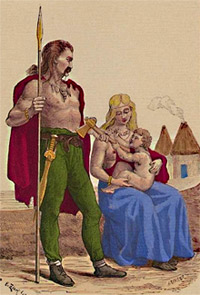 The Roman Empire fell by invasions of Germanic peoples, whom they called "barbarians"; they exploit the weakened situation of the empire to besiege their cities and to conquer their domines. By this reason, when the first kingdoms of Germanics, Franks and Visigoths were formed, customs about hair dressings will be brought by them.
The Roman Empire fell by invasions of Germanic peoples, whom they called "barbarians"; they exploit the weakened situation of the empire to besiege their cities and to conquer their domines. By this reason, when the first kingdoms of Germanics, Franks and Visigoths were formed, customs about hair dressings will be brought by them.
Germans attached great importance to hair. Even they had military and social hierarchies based on how long the hair was. They tied their hair in the top of their heads to create a high knot what made they seem taller and more scary in the battles. For them, the worst humiliation was to lose the hair. Hair was a symbol of power and authority. Slaves and war prisoners were utterly shorn. A shorn head was for them a sign of total submission.
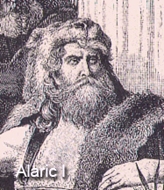 Alaric I, king of Visigoths, plundered and occupied Rome in 410, causing the final collapse of the Roman Empire. Since that time, costumes of Germanic people started to be popular throughout Europe. At the end of the V century, the Franks of the Merovingian Dynasty occupied almost the entire continent, being succeeded by the Carolingian Dynasty, which begins with the Holy Roman German Empire. All these kings looked long-haired and bearded. When, in the 5th century, appear the first Merovingian kingdoms, their kings wore a long and flowing hair, parted in the center, and those who were under their authority, shorter. It was at that time the hairstyle, which little by little replaced the clean shaven polite Roman hairstyle. Merovingians imposed the style of their original people, creating a real hierarchy according to hair length. One way to avoid that some descendant (son or nephew) sought access to the throne, was to cut their hair. That was a complete disqualification. Monks of the Catholic Church, who at that time already started to get important influence in those countries, were a tonsure, what is a round bald spot on the top of the head; the tonsure is a sign of submission to a superior authority. When those Merovingian kings wanted to get rid of some undesirable relative with pretensions to the throne, they "tonsured" and sent him to a monastery. Chlodio V, a Merovingian king, (390-450, approximately) was precisely nicknamed "le chevelu" ("long hair"), because he wore his hair longer than his predecessors.
Alaric I, king of Visigoths, plundered and occupied Rome in 410, causing the final collapse of the Roman Empire. Since that time, costumes of Germanic people started to be popular throughout Europe. At the end of the V century, the Franks of the Merovingian Dynasty occupied almost the entire continent, being succeeded by the Carolingian Dynasty, which begins with the Holy Roman German Empire. All these kings looked long-haired and bearded. When, in the 5th century, appear the first Merovingian kingdoms, their kings wore a long and flowing hair, parted in the center, and those who were under their authority, shorter. It was at that time the hairstyle, which little by little replaced the clean shaven polite Roman hairstyle. Merovingians imposed the style of their original people, creating a real hierarchy according to hair length. One way to avoid that some descendant (son or nephew) sought access to the throne, was to cut their hair. That was a complete disqualification. Monks of the Catholic Church, who at that time already started to get important influence in those countries, were a tonsure, what is a round bald spot on the top of the head; the tonsure is a sign of submission to a superior authority. When those Merovingian kings wanted to get rid of some undesirable relative with pretensions to the throne, they "tonsured" and sent him to a monastery. Chlodio V, a Merovingian king, (390-450, approximately) was precisely nicknamed "le chevelu" ("long hair"), because he wore his hair longer than his predecessors.
MEROVINGIAN KINGS HAIRSTYLE :
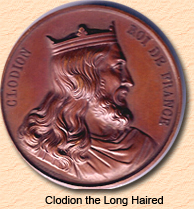 |
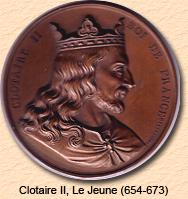 |
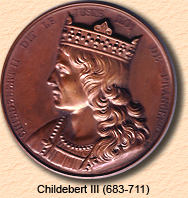 |
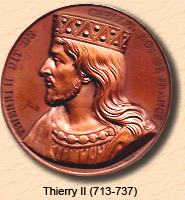 |
At the beginning of the reign of Charlemagne in the 8th century, it was established a strong alliance with the Pope of Rome, founding the Holy Roman German Empire. Charlemagne brought to his kingdom the old Roman costumes, and men started to use their hair shorter and more meticulously groomed. Beards and long hair were then considered a symbol of paganism by the Catholic Church. Short and neatly combed hairstyle was pretty much "Roman", as opposed to the barbarous paganism of former periods and more in tune with Christianity. The king of France Louis II, obeying a clerical imperative from the Pope, fully shaved his face and cut his hair almost like a monk.
CAROLINGIAN KINGS HAIRSTYLE :
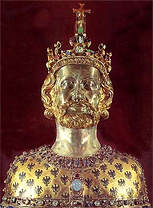 |
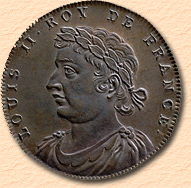 |
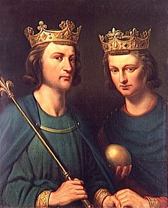 |
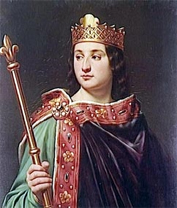 |
| Charlemagne (740-814) | Louis II (846-879) | Louis III and Carloman (879-882) | Louis V (967-987) |
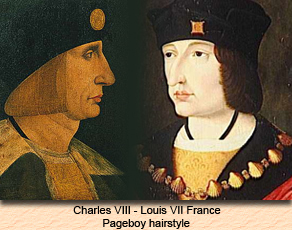
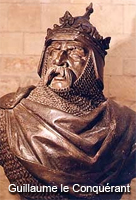 Near the 10th century, the Catholic Church began issuing edicts against the length of men's hair, and the need to cover with veils the women's heads. In 1073, the Pope Gregory VII banned the use of beard and moustaches among the clergy, and clergymen, then, started to give instructions to the population recommending to shave their beards in order to be a good Christian. It was obviously a way to look different of other cults. In 1096 the Archbishop of Rouen announced that men who wore beards would be excommunicated from the Church. A similar ecclesiastic decree was promulgated in Venice in 1102. The British king Henry I accepted in 1130 to cut his hair and his beard, under the pressure of the Church. Since then, and until the 15th century, it was rare to see beards in men. Haircuts were used no longer than the nape and all the faces were clean shaven. Images of William the Conqueror, duke of Normandy and later king of England, are depicted only with moustaches, though among the Normans the use of beards were very important to separate mature males from youths. From the 11th century on, was very popular the "pageboy hairstyle ", which was a haircut with a bang on the forehead and the hair curved over the ears up to the neck. In the famous Bayeux tapestry, a 224 feet long embroidered cloth, made in Normandy, France, in the 11th century, which tells the story of the British Islands' conquest by the Norman French, are depicted images showing how the men used the hair at that time.
Near the 10th century, the Catholic Church began issuing edicts against the length of men's hair, and the need to cover with veils the women's heads. In 1073, the Pope Gregory VII banned the use of beard and moustaches among the clergy, and clergymen, then, started to give instructions to the population recommending to shave their beards in order to be a good Christian. It was obviously a way to look different of other cults. In 1096 the Archbishop of Rouen announced that men who wore beards would be excommunicated from the Church. A similar ecclesiastic decree was promulgated in Venice in 1102. The British king Henry I accepted in 1130 to cut his hair and his beard, under the pressure of the Church. Since then, and until the 15th century, it was rare to see beards in men. Haircuts were used no longer than the nape and all the faces were clean shaven. Images of William the Conqueror, duke of Normandy and later king of England, are depicted only with moustaches, though among the Normans the use of beards were very important to separate mature males from youths. From the 11th century on, was very popular the "pageboy hairstyle ", which was a haircut with a bang on the forehead and the hair curved over the ears up to the neck. In the famous Bayeux tapestry, a 224 feet long embroidered cloth, made in Normandy, France, in the 11th century, which tells the story of the British Islands' conquest by the Norman French, are depicted images showing how the men used the hair at that time.

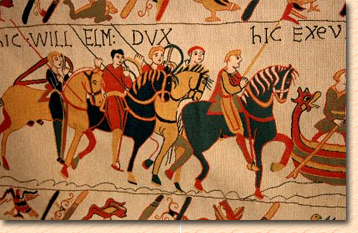
WOMEN'S HAIR AT THE MIDDLE AGES :
During the first period of the Medieval era, ranging from the fifth to the eleventh century, women usually had long hair, extended to knee length or sometimes, below, and also with two long braids at the sides of the head or tied in a chignon. Along almost all the Middle Ages period, women arranged their hair to reveal their complete foreheads; often they shaved the hair around the hairline to give an appearance of a higher line. The forehead was at that time considered a very important feature of the face. They used to cover it with artificial flowers, headbands, or precious jewelry, but never with hair. Women's hair was considered itself, at this period, an erotic feature. In consequence, married woman had to cover it with veils. The married woman's hair was legally considered as a property of the husband. Near the end of the Middle Ages, the Catholic Church issued religious decrees for the veils were obligatory for all women. One of the most popular hairstyles from the Middle period until the Late period was to secure the braids in chignons at either side of the head, above each ear, held by golden or silk threads. Another popular style in the 13th and 14th century was to make three or four braids and to tie them at the back of the head with fine nettings with ornaments. At the beginning of the period, women used their hair natural, but since the Middle period and up to the end, the public exhibition of the hair was considered unseemly and disrespectful. They also wore high hats and bonnets to attend Church or in public places.
"THE WOMAN WHO WEARS A WIG COMMITS A MORTAL SIN"
 Saying this, Saint Bernard de Clairvaux confirmed at the XII century the position of the early fathers of the Church. They denounced the wig as an invention of the Evil One. St Jerome, -the author of the Latin Vulgate Bible-, at the 4th century, condemning the hedonistic lifestyle, declared these adornments not tolerated by the Church and unworthy of Christianity. From the first council of Constantinople, wigs receive condemnation as a serious offense to God. Clemens of Alexandria said that who wears a wig at church when receiving a benediction, must keep in mind that the blessing would remain in the wig, and would not pass through to the wearer. People immediately removed their wigs. St Gregory of Nazianzus, as a proof of the virtue of his sister Gorgonia, said: "she neither cared to curl her own hair, nor to repair her lack of beauty by the aid of a wig". This point of view would be enforced along several centuries.
Saying this, Saint Bernard de Clairvaux confirmed at the XII century the position of the early fathers of the Church. They denounced the wig as an invention of the Evil One. St Jerome, -the author of the Latin Vulgate Bible-, at the 4th century, condemning the hedonistic lifestyle, declared these adornments not tolerated by the Church and unworthy of Christianity. From the first council of Constantinople, wigs receive condemnation as a serious offense to God. Clemens of Alexandria said that who wears a wig at church when receiving a benediction, must keep in mind that the blessing would remain in the wig, and would not pass through to the wearer. People immediately removed their wigs. St Gregory of Nazianzus, as a proof of the virtue of his sister Gorgonia, said: "she neither cared to curl her own hair, nor to repair her lack of beauty by the aid of a wig". This point of view would be enforced along several centuries.
----------------------------------------------------------------------------------------------------------------------------------------------------------------
WOMEN HAIRSTYLES AT THE MIDDLE AGES
---------------------------------------------------------------------------------------------------------------------------------------------------------------
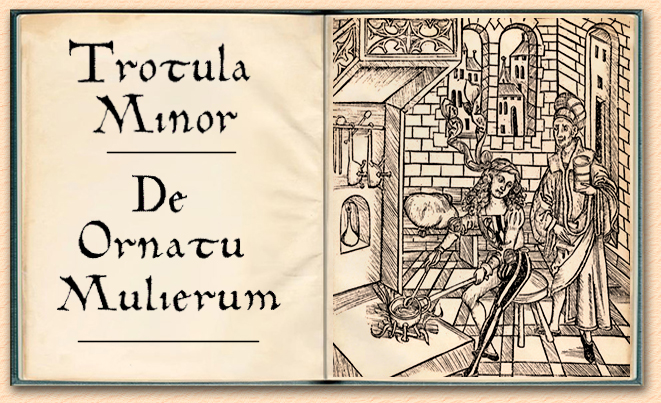
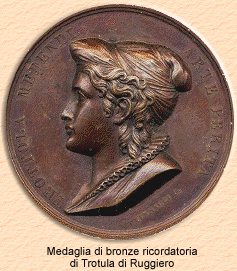 La Scuola Medica Salernitana (the Medical School at Salerno, in Southern Naples, Italy) was an institution of medical teaching, in the 12th century, which had condensed the knowledge of old treatises of Latin, Greek, Arabian and Hebrew medicine. It was the most important school of medicine in Europe at the Middle Ages, being the predecessor of the modern university. A woman at that time had the honor of held a chair in the medicine's cathedra: the famous Trotula di Ruggiero. The daughter of a noble family of Salerno, she was very soon a celebrity in Europe, having until today legendary connotations. Trotula left written important medical treatises, especially dedicated to women, and even she stepped beyond the medicine writing a treaty of cosmetics. Her works were: "De passionibus mulierum ante in e post partum", or Trotula Major, (diseases of women before and after the childbirth) "De Ornatu Mulierum" (recipes for cosmetics), or Trotula Minor; and "Practica Secundum Trocta" (medical practice according with Trotula). Today is a dispute about the autoship of minor treatises, as the cosmetics treaty, but nonetheless all of them are gathered under the title "Trótula", although many historians think that they are independent works grouped under the name of the famous Magistra Mulier Sapiens (the wise professor). Trotula's work has been completely translated to English in 2001 by Monica Green.(A Medieval Compendium of Women's Medicine. Edited and translated by Monica H. Green. (Philadelphia: University of Pennsylvania, 2001).
La Scuola Medica Salernitana (the Medical School at Salerno, in Southern Naples, Italy) was an institution of medical teaching, in the 12th century, which had condensed the knowledge of old treatises of Latin, Greek, Arabian and Hebrew medicine. It was the most important school of medicine in Europe at the Middle Ages, being the predecessor of the modern university. A woman at that time had the honor of held a chair in the medicine's cathedra: the famous Trotula di Ruggiero. The daughter of a noble family of Salerno, she was very soon a celebrity in Europe, having until today legendary connotations. Trotula left written important medical treatises, especially dedicated to women, and even she stepped beyond the medicine writing a treaty of cosmetics. Her works were: "De passionibus mulierum ante in e post partum", or Trotula Major, (diseases of women before and after the childbirth) "De Ornatu Mulierum" (recipes for cosmetics), or Trotula Minor; and "Practica Secundum Trocta" (medical practice according with Trotula). Today is a dispute about the autoship of minor treatises, as the cosmetics treaty, but nonetheless all of them are gathered under the title "Trótula", although many historians think that they are independent works grouped under the name of the famous Magistra Mulier Sapiens (the wise professor). Trotula's work has been completely translated to English in 2001 by Monica Green.(A Medieval Compendium of Women's Medicine. Edited and translated by Monica H. Green. (Philadelphia: University of Pennsylvania, 2001).
"De Ornatu Mulierum", a work widely read at the time and in later centuries, gives a huge importance to the physical beauty as a sign of body health and harmony with the universe. Unlike another treaties of the time, this one does not include neither prays, enchantments, astrology, nor any form of superstition. Its cosmetic methods are based in the use of vegetal species, - the School of Salerno had a garden with 300 curative species called "The Garden of Minerva"-, and in the use of animal fats. That is why those cosmetic products were much more oily than the current today, but on the other hand, it allowed greater retention in the skin. Of all the vegetal species recommended by the treaty, most of them are currently in use by the actual cosmetic industry; and other elements recommended by Trotula, such as mercury, are actually forbidden.
RECOMMENDED RECIPES IN "DE ORNATU MULIERUM" FOR THE HAIRCARE: FOR BLOND HAIR DYE : 1) For coloring the hair so that it is golden. Take the exterior shell of a walnut and the bark of the tree itself, and cook them in water, and with this water mix alum and oak apples, and with these mixed things you will smear the head (having first washed it) placing upon the hair leaves and tying them with strings for two days; you will be able to color. And comb the head so that whatever adheres to the hair as excess comes off. Then place a coloring which is made from oriental crocus, dragon's blood, and henna (whose larger part has been mixed with a decoction of brazilwood) and thus let the woman remain for three days, and on the fourth day let her be washed with hot water, and never will be removed easily. 2) Let cabbage stalks and roots be pulverized and let pulverized shavings of boxwood or ivory be mixed with them, and it should be pure yellow. And from these powders, let there be made a cleanser which makes the hair golden. TO OBTAIN LIGHT HAIR : -After leaving the bath, let her wash the hair with a cleanser such as this: take ashes of burnt vine, the chaff of barley nodes, and licorice wood (so that it may the more brightly shine), and sowbread. Boil the chaff and the sowbread in water. With the chaff and the ash and the sowbread, let a pot having at its base two or three small openings be filled. Let the water in which the sowbread and the chaff were previously cooked be poured into the pot, so that it is strained by the small openings. With this cleanser let the woman wash her head. After the washing, let her leave it to dry by itself, and her hair will be golden and shimmering. TO DYE THE HAIR OF BLACK COLOR : -First, apply a mixture made cooking a green lizard in oil without its tail and head. Then, let oak apples be placed with oil in a dish and let them be burned. Then let them be pulverized and placed in vinegar in which there has been placed blacking made in Gaul, and let them be mixed. ENCOURAGING HAIR GROWTH : -Take barley bread with the crust, grind it with salt and bear fat. But first burn the barley bread. With this mixture anoint the place and the hair will grow. In order to make the hair thick, take agrimonies and elm bark, root of vervain, root of willow, southernwood, burnt and pulverized linseed, and root of reed. Cook all these things with goat milk or water, and wash the area (having first shaved it). . |
What is really interesting about De Ornatu Mulierum is that all these formulas and recipes for hair care, of course, work properly and very well. Analyzing the prescription above, to dye the hair blond, we'll notice that in first place they are making a process of discoloration with a strong astringent compound: nuts and alum; oak apples contribute with tannic acid, which helps discoloration, and in addition is a powerful antibacterial, antienzymatic and astringent. Later, depending of the proportions of the colorant, (henna, dragon blood and saffron) from a golden-orange to a raspberry color may be obtained. And, what is still more interesting, with no damage for the hair. These formulas are the result of researches along centuries, in alchemic laboratories, and the fruit of countless experimentation.
In this ancient treaty was believed that seborrhea and dandruff were produced by worms growing under the scalp, and in order to eliminate them was recommended washing the hair with vinegar, rosemary water, nettles, mint, thyme and other herbs. And all of that, anyway, helped to the capillary hygiene and to the health of the scalp.
De Ornatu Mulierum had more than 100 manuscripts circulating by all Europe for several centuries.

As the Renaissance was a time of a real intellectual, cultural, philosophic and religious revolution, it also led to a change in costumes, and the hairstyles, in some way, reflected a transition to more independence of thought. It is a period historically classified from the 15th century until the beginning of the 17th century. There was a rebirth of culture and art in general, and a reunion with the Greek and Latin traditions. It was a time of great painters, sculptors, philosophers, scientists and religious leaders as Martin Luther and John Calvin.
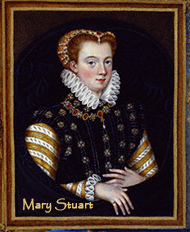
 Women started to expose their hair, because at the diffusion of Protestantism, especially in England and Netherland, the pressure of the Catholic Church and the Pope of Rome would be lesser. There was more freedom in costumes than in the Middle Ages, and men had the choice whether or not to use beard or moustaches, a long hair at the nape length, or shorter. Women still emphasized, like in the former period, in showing their whole foreheads. They preferred taller hairstyles, adorned with headbands or jewels or gem stones. In England, the queen Elizabeth I (1558-1603), made popular a reddish-gold hair color hairstyle -which was her natural hair- and tall hear dresses with a very exposed forehead. Her cousin Mary Stuart, queen of Scots, wore a hairstyle with the hair arranged over a heart-shaped wire frame. The queens' hairstyles had influence, naturally, on women in general.
Women started to expose their hair, because at the diffusion of Protestantism, especially in England and Netherland, the pressure of the Catholic Church and the Pope of Rome would be lesser. There was more freedom in costumes than in the Middle Ages, and men had the choice whether or not to use beard or moustaches, a long hair at the nape length, or shorter. Women still emphasized, like in the former period, in showing their whole foreheads. They preferred taller hairstyles, adorned with headbands or jewels or gem stones. In England, the queen Elizabeth I (1558-1603), made popular a reddish-gold hair color hairstyle -which was her natural hair- and tall hear dresses with a very exposed forehead. Her cousin Mary Stuart, queen of Scots, wore a hairstyle with the hair arranged over a heart-shaped wire frame. The queens' hairstyles had influence, naturally, on women in general.
In this paint of the Flemish Baroque artist Anthony Van Dyck, of 1620, where is pictured he and his family, at the right, we can appreciate a typical hairstyle of the people of the Renaissance. And in this detail of the Rembrandt's work "The Anatomy Lesson of Dr. Nicholaes Tulp", at the left, another hairstyle of 1632 in Netherland.
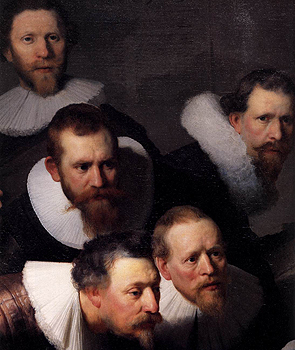 |
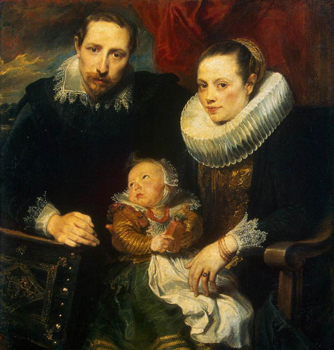 |

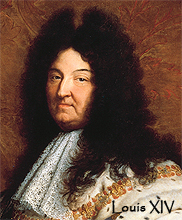 Men usually wore a short beard, and very spruced up: trimmed in decorative shapes, with scented pomades or waxes to secure the style; at night, they wore wooden presses to preserve their beards styles. The legend says that these hairstyles became in fashion because the king Francis I of France burned the tip of his hair with a torch, and from that moment his subjects started to use hair and beards shorter. Near 1650, the Sun King, Louis XIV of France, (1643-1715) put in fashion a long hair with thick curls, which, when he started to loose his hair, he wore with the addition of wigs. Since then, and during all the 17th and 18th centuries, men adopted wigs as their preferred look. It was also a new source of jobs for designers and manufacturers of wigs, who were the former barbers now focused in the flourishing wig industry.
Men usually wore a short beard, and very spruced up: trimmed in decorative shapes, with scented pomades or waxes to secure the style; at night, they wore wooden presses to preserve their beards styles. The legend says that these hairstyles became in fashion because the king Francis I of France burned the tip of his hair with a torch, and from that moment his subjects started to use hair and beards shorter. Near 1650, the Sun King, Louis XIV of France, (1643-1715) put in fashion a long hair with thick curls, which, when he started to loose his hair, he wore with the addition of wigs. Since then, and during all the 17th and 18th centuries, men adopted wigs as their preferred look. It was also a new source of jobs for designers and manufacturers of wigs, who were the former barbers now focused in the flourishing wig industry.
MEN HAIRSTYLES AT THE RENAISSANCE :
In Venice, to dye their hair (preferable of blond color), women applied different recipes and later, they exposed their heads to the sun for several hours, using a special hat (with no top) what they called solana. It was a rite which supposed a huge sacrifice to beautify their hair. It's unclear what role played in that process the exposition to the sun, given that most of the formulas made to decolorize the hair were made in base of lye and astringent products, which means that, without an exposition to the sun they would have worked anyway; but the ceremony of being installed down the sun rays was anyhow accomplished.
WOMEN HAIRSTYLES AT THE RENAISSANCE :
THE ELIXIRS OF NOSTRADAMUS, by Michel of Nostradamus, in the year 1550:
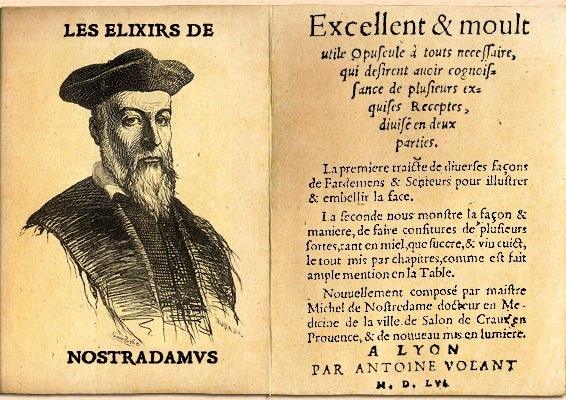
Part 1, Chapter XXIV: How to make the hair golden blond, no matter how black or white it is, making it pale yellow without losing its colour for a long time, and retaining it in its entirety, and making it grow in such a way as to be that colour right down to the root, just as it is to the very tip.
Take a pound of twigs of the wood called fustet, ground to a fine powder, half a pound of box-wood shavings, four ounces of fresh liquorice, four ounces of nice, dry, yellow orange-peel, four ounces each of celandine root and papaver, two ounces of the leaves and flower of glaucium or guelder-rose [?], half an ounce of saffron, and half a pound of paste made from finely ground wheat flour.
Boil it all up in some lye made with half pounded ashes and then pour it all out [through a strainer?].
Next, take a large earthenware pot or jar, and make ten or twelve little holes in the bottom.
Then afterwards take equal quantities of sacred ash [?] and pounded wood-ash and put them in some large wooden mortar or something of the kind, as you please, and sprinkle them with the said concoction while pounding them vigorously for the best part of a day.
Keep doing so until the ash is fairly hard, and while pounding it add a little rye- and wheat-straw, continually pounding it so that it soaks up most of the concoction.
Then take the said pounded ashes and put them in the said pot or jar, and in each of the holes in the said pot stick an ear of rye that passes out to the exterior and make alternate beds of straw and ashes until the said pot is full, but leave a little room for the rest of the concoction.
Then, towards evening, position another pot or jar to collect the lye that dribbles out of the holes along the ears of rye.
When you want to use it in the morning, go and see what has oozed out, sponge it up and apply it to the hair by wiping.
And at the end of three or four days you will have hair that is as golden-blond as a golden ducat.
But before you put it on your head, wash it with another good lye, because if it were greasy it wouldn't take so easily.
And you must understand that the contents of the present recipe are sufficient for one or two years, and are sufficient, if used properly, for the needs of ten or twelve women, for only a little of the liquor is sufficient to colour the hair quickly and easily, and there is no need to wash with anything other than this for a woman whose hair was black as coal to become quickly blond, and for a very long time.
(Traité des fardemens et confitures, English translation by Peter Lesmesurier, http://www.propheties.it/nostradamus/1555opuscole/opuscole.html)
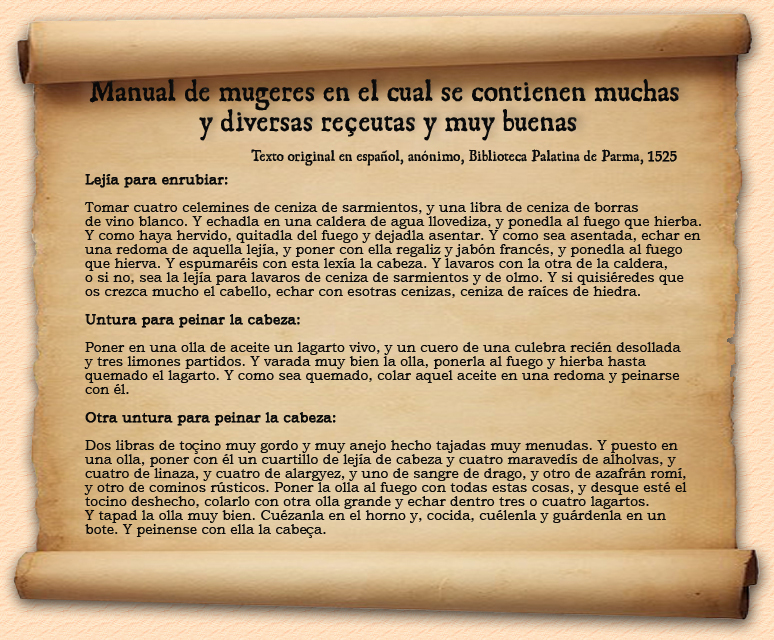
ENGLISH TRANSLATION:
"Manual of Women in which is contained many and diverse very good recipes"
Lye to turn hair blond
Take four celemines of vine-shoot ash, and one pound of ash of the lees of white wine. And add in a pot of rainwater, and put it over a fire that boils. And when it boils, take it off the fire and leave it to sit. And as it is sitting, add a flask of that lye, and put with it licorice and French soap, and put it to the fire that boils. And skim the head with this lye. And wash with the other from the pot, or if not, it is the lye to wash the vine-root ash and elm ash. And if you want to the hair to grow quickly, throw in with those other ashes, ashes from ivy roots.
Unction to comb the head
Put in a stew-pot the oil of a live lizard, and the recently moulted skin of a snake and three cut lemons. And set afloat the stew-pot very well, and put it to the fire and boil until the lizard has burned. And when it has burned, strain that oil in a flask and comb your hair with it.
Another unction to comb the head
Two pounds of very fat and very well-blended bacon cut into small pieces. And put it in a stew-pot, put with it a fourth part of head lye and four maravedís of alhovas, and a fourth of linseed, and a fourth of barberry, and a (fourth) of calamus gum, and another (fourth) of bastard saffron (safflower), and another (fourth) of rough cumin. Put the stew-pot on the fire with all these things, and once the bacon comes apart, strain it with another large stew-pot and throw in three or four lizards. And put the lid on the stew-pot very well. Cook it in the oven and, when cooked, strain it and keep it in a bottle. And comb your hair with it.
| DEUTSCH |
ENGLISH |
ESPAÑOL |
FRANÇAIS |
ITALIANO |
русский |
SRPSKI |
| Start | The Hair | What the Hair is | Prehistory | Mythology | Old Age (1st. part) | Old Age (2nd. part) |
| Middle Ages/Renaissance | 18th Century | 19th Century | 20th Century | Barbers' History | The End | Contacto |